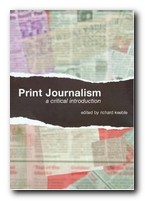essays on journalism – from print to the Internet
More than 12.5 million national newspapers are sold in Britain every day. The figure goes up to 14 million on Sundays. And for every copy of the Guardian sold each day, ten copies of the Sun cross the counter – which is what led former Sun editor Kelvin McKensie to rather cruelly call the Guardian ‘the world’s worst newspaper’. This publication covers every possible aspect of print journalism, and I suspect it has been produced in the hope of becoming a standard text in departments of journalism and media studies.
 The chapters are written by ex-journalists now teaching at four universities – City London, Sheffield, Cardiff, and Lincoln – so it seems there must be a regular career path leading out of the Street of Shame and showing other people the best way to get there. Articles in the first section deal with the history, structure, and the financing of print media. Who owns what; which titles sell most copies; and how they make a profit.
The chapters are written by ex-journalists now teaching at four universities – City London, Sheffield, Cardiff, and Lincoln – so it seems there must be a regular career path leading out of the Street of Shame and showing other people the best way to get there. Articles in the first section deal with the history, structure, and the financing of print media. Who owns what; which titles sell most copies; and how they make a profit.
There’s a certain amount of overlap and repetition here, but it’s not necessarily a bad thing, because the newspaper and magazine publishing business is a lot more complex than it appears on the surface. The second section gets straight down to practical advice for would-be journalists: how to be a reporter; how to conduct interviews; what makes a good news story; how to write good introductions and structure paragraphs.
Then, moving into the newsroom itself, there are chapters on the role of news editor, what sub-editors do, and how pictures are captioned. The individual essays could profit enormously from more illustrative examples, and almost every page is crying out for graphics.
The would-be journalist is given a detailed breakdown of news features, and more importantly how to successfully pitch your ideas to editors, then how to write them if and when they are accepted.
Once you have written your piece and checked it several times over for style, content, accuracy, spelling, and grammar, it then goes to a features editor who will edit it all over again. There’s a whole chapter explaining this process. It’s a tough world, and this is required reading for anybody who wants to make a success of freelance writing.
You are unlikely to be invited to write comment or opinion pieces, but you could break into print via reviewing. How to write them is explained in detail – and these days its as likely to be reviewing radio and TV programmes as traditional books and theatre performances.
Print journalism is now as we know being challenged by the online world – though you are even less likely to earn income from it. There are essays which analyse the differences between newspapers’ print and online versions, and technical advice on how monitor screen and web browsers affect how and what we read on screen.
There’s also advice on writing blogs and wikis, before the collection winds up with essays on the ethics and law in journalism, copyright, and intellectual property rights – which is one of the best short explanations of a complex issue I have seen for quite some time.
© Roy Johnson 2005
Richard Keeble (ed), Print Journalism: a critical introduction, London: Routledge, 2005, pp.347, ISBN: 0415358825
More on journalism
More on creative writing
More on writing skills
More on publishing